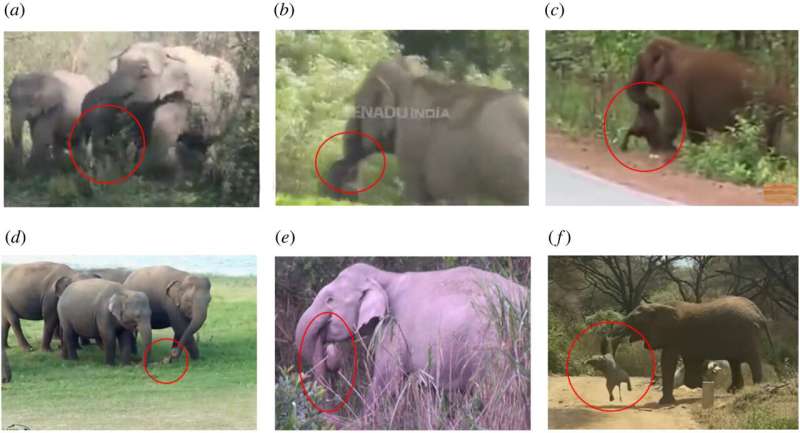Dead calf carrying by adult female wild Asian elephants (n = 5 cases out of 25 total cases) and African elephant. These still images were retrieved from (a) Video 1 (channel: monismukhtar1), (b) Video 21 (channel: ETV Bharat English; Case #11), (c) Video 28 (channel: Buzz news; Case #16), (d) Video 35 (channel: Lanka Wild Safari; Case #22) and (e) Video 40 (non-YouTube data: from co-author R.S., data archive; Case #25; refer to electronic supplementary material, table S1, for more details). For comparative documentation, we provide a still image (f) from a 44 s long video of an African female elephant holding a dead calf by her tusk and trunk at the Lake Manyara National Park, Tanzania (clip source: Fay Amon, 29 August 2021; Facebook; https://fb.watch/aMDA94fK_z/). Credit: Royal Society Open Science (2022). DOI: 10.1098/rsos.211740
A team of researchers at the Indian Institute of Science, has analyzed YouTube videos captured by amateur elephant enthusiasts to learn more about how the animals respond when one of their herd members dies. Their paper is published in the journal Royal Society Open Science.
Prior evidence has shown that some creatures besides humans, such as apes and dolphins, respond to the death of a member of their group, particularly mothers to the death of their offspring. In this new effort, the researchers noted that little research has been done to learn more about how elephants respond when one of their own passes away. They noted that it is difficult to capture video evidence of elephants reacting to death due to its rarity. Researchers cannot simply venture out into the wilds and follow elephants around until one of them dies because of time constraints. Instead, the researchers guessed that others have witnessed such events by accident and many of them may have recorded the action using their smartphone and posted it on social media, most specifically, on YouTube.
To find out if that was the case, the researchers conducted a large number of YouTube searches using terms such as "elephant death." They found 24 videos that feature elephants reacting to the death of one of their herd members, typically, one that was very young.
The researchers found the most common reaction was touching the corpse. They also observed sniffing. Touching was generally confined to the face or ears. The researchers noted that members of an elephant group also produced varying types of noise in reaction to a death, and some tried to animate the dead creature.
The researchers suggest that elephants not only notice when one of their members dies, but actively mourn them, particularly mothers for their dead offspring. In five such cases, mothers were seen carrying their dead calf for several days following its death.
More information: Sanjeeta Sharma Pokharel et al, Viewing the rare through public lenses: insights into dead calf carrying and other thanatological responses in Asian elephants using YouTube videos, Royal Society Open Science (2022). DOI: 10.1098/rsos.211740
Journal information: Royal Society Open Science
© 2022 Science X Network
























